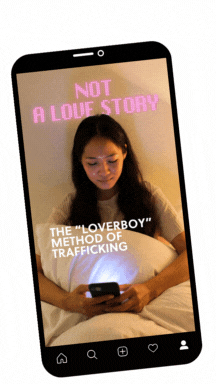HOW HUMAN TRAFFICKING HAPPENS
Trafficking Scenarios
Learn to recognize human trafficking and the different ways it happens. Below, you’ll some common trafficking scenarios. However, please know that there are more ways human trafficking can occur, so continue to learn and stay engaged with EverFree’s resources.
COMMON SEX TRAFFICKING SCENARIOS
Sarah is a young woman who has had a difficult life. She struggles to make ends meet, and past relationships have left her heartbroken.
One day, while out with friends, she meets Mark. He showers her with gifts, cares for her, listens to her, texts and calls her every day.
Over time, Sarah falls deeply in love with Mark. Mark makes her feel like he is the only one she can trust, that her friends and family could never love her or take care of her the way he does.
He tells Sarah that he does so much for him, and that the least she can do is contribute to their finances more. He pressures her into creating pornographic content to sell online. He promises that they will make enough money to enjoy an amazing life together.
But she hates creating the pornographic content and is deeply uncomfortable while Mark controls all of their income. She wants to break things off, but Mark gets aggressive and violent.
Sarah feels trapped.
This scenario illustrates the “Loverboy Method” of trafficking, also known as “Romeo Pimping”. A trafficker charms, isolates, and manipulates a victim through a romantic relationship in order to exploit a victim for commercial sex.
Daniela, a 15-year-old high schooler, receives a message on Instagram:
– Hello, my dear. I came across your profile, and I have to say, you are so beautiful! I actually run a modeling agency and we would love to work with you.
Daniela looks through the woman’s account, amazed at her number of followers and how beautiful she was, how luxurious her posts were. Daniela replies, asking where the agency is. She tells her where it is and asks if she could come in so that they can take some Polaroids. Later that week, Daniela takes the train to the address. When she arrives, she sees the woman and another man with a camera. Daniela feels excited about the potential of a modeling career.
They start with a few photos, but the woman tells Daniela that she has to change into better clothes to get the right shots. She has Daniela change into very revealing clothes for the next few photos. Afterwards, another man came into the studio. The woman instructs Daniela, that he has a lot of contacts in the industry, that if she made did what he wanted, she could have a glamorous lifestyle too. The woman pressures Daniela into having sex with him. She tells her that this is the way she can succeed. The woman tells Daniela that she has more contacts with high fashion brands, and that making them happy could make her modeling dreams come true.
This scenario illustrates sex trafficking through promises of a career or of making the victim’s dreams come true. Here, the trafficker uses Instagram to lure a young victim, which has become more common with the use of social media.
Scenario One: Vincent is an 11-year-old boy. His parents struggle to pay rent and last night their landlord threatened to kick them out. At night, his mother sells sex, but his parents argue about the money not being enough. They tell Vincent that he can help their family and his siblings. They force him into commercial sex.
Scenario Two: Gemma is a ten-year-old girl. Her younger sister Rosa is very sick. Their mother says that it would be impossible to pay for her medicine unless they had more money. She tells Gemma that they can pay for Rosa’s medicine if Gemma helps her mother make money online. Gemma’s mother creates child sexual abuse material of Gemma, telling her that it’s okay because she is her mother. She sells the material online.
It is important to note that traffickers may not always be strangers. They can be friends, neighbors, partners, or family members. Scenario 1 illustrates familial sex trafficking through prostitution. Scenario 2 shows how children may often be exploited for child sexual abuse material consumed online.
It’s not a love story.
Watch our reel about how the “Loverboy” method of trafficking happens.
COMMON LABOR TRAFFICKING SCENARIOS
Judith, a young woman from Uganda, saw an opportunity for a better life when she was promised a job as a domestic worker in the UAE. With dreams of supporting her family back home, she eagerly accepted the offer, unaware of the deception that awaited her. The recruitment agency painted a rosy picture of high wages and comfortable living conditions, but upon arrival, her employer confiscated Judith’s passport. She was subjected to long hours and abuse. She was prevented from leaving or contacting anyone. Judith’s employer also denied her her wage, and refused her medical care when Judith fell ill from her harsh working conditions. Judith’s employer also told her that he was friends with local law enforcement, and that he would have her arrested if she attempted to leave.
This scenario is common for labor trafficking. Overseas workers are promised an opportunity to earn money abroad, but are instead exploited. Being abroad adds a further layer of difficulty for victims as they struggle to find help or communicate. Their employers may also threaten them with local law enforcement.
Emil accepts work abroad through a recruitment agency. He was promised a good salary and a place to live. However, upon arriving at his new place of employment he is charged extra exorbitant fees for travel, housing, and processing—fees that would be impossible for him to pay back. His employer keeps his identity documents and threatens him with his debt, forcing him to stay and work for it.
This is a situation of debt bondage, where employers and recruiters plunge victims into high amounts of debt in order to maintain control.
The everyday goods we consume may be made through exploitation and trafficking. Here are a few examples.
Chocolate: According to the US Department of Labor, 1.56 million children are forced into labor on cocoa farms in Ghana and Cote d’Ivoire, the two countries producing 60% of the world’s cocoa each year.
Fashion: Garment workers around the world are at high risk for exploitation, with many working 14-16 hours a day in harsh environments. Fast fashion has only worsened exploitation, as less than 2% of fast fashion laborers earn a living wage. Often, many of these laborers are children (The True Cost, Fashion Revolution).

